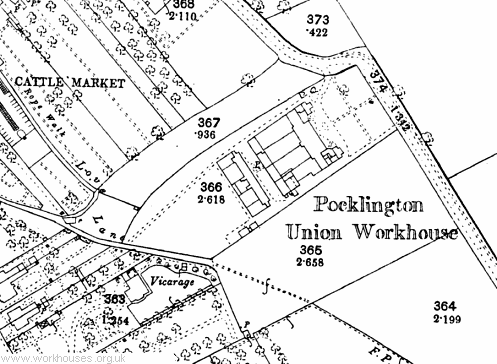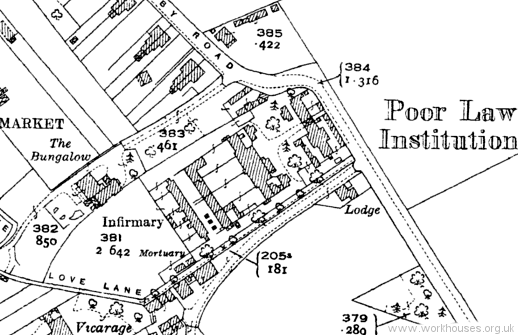Pocklington, East Riding of Yorkshire
Up to 1834
A parliamentary report of 1777 recorded a workhouse in operation in Pocklington with accommodation for up to 12 inmates. The workhouse inmates were hired out for use as farm labour or to work on the roads.
Eden, in his 1797 survey of the poor in England, reported of Pocklington that:
Table of diet : Breakfast—every day, milk and oatmeal. Dinner—Sunday, butchers' meat ; Monday, hasty pudding ; Tuesday, dumplins of wheatmeal ; Wednesday, meat and potatoes ; Thursday, baked pudding ; Friday, frumenty of shop barley ; Saturday, boiled potatoes and melted butter. Supper, every day, milk and bread.
A workhouse was built in Market Weighton in the mid-1780s. Very few paupers were ever in the workhouse as it was found that giving paupers weekly pensions was a cheaper option.
After 1834
Pocklington Poor Law Union was formed on 22nd October 1836. Its operation was overseen by an elected Board of Guardians, 49 in number, representing its 47 constituent parishes and townships as listed below (figures in brackets indicate numbers of Guardians if more than one):
East Riding: Allerthorpe, Barmby-on-the-Moor, Bielby, Bishop Wilton with Belthorpe, Bolton, Bugthorpe, Burnby, East Cottingwith, East Stamford Bridge, Everingham, Fangfoss with Spittle, Fridaythorpe, Full Sutton, Goodmanham, Great Givendale and Grimthorpe, Harswell, Hayton, High Catton, Huggate, Kilnwick Percy, Kirby-under-Dale, Londesborough and Esthorpe, Low Catton, Market Weighton and Arras (2), Melbourne, Millington with Little Givendale, Newton upon Derwent, North Cliff, Nun Burnholme, Ousthorpe, Pocklington (2), Sancton and Houghton, Scrayingham, Seaton Ross, Shipton, Skirpenbeck, South Cliff, Storthwaite, Sutton-upon-Derwent, Thixendale, Thornton, Thorpe le Street, Waplington, Warter, Wilberfoss, Yapham with Meltonby, Youlthorpe with Gowthorpe.
The population falling within the Union at the 1831 census had been 14,236 with parishes ranging in size from Waplington (population 18) to Pocklington (2,048). The average annual poor-rate expenditure for the period 1834-6 had been £7,564 or 10s.8d. per head of the population.
Prior to 1851, the Board of Guardians met on alternate Saturday lunchtimes at the Plume of Feathers on Swine Market.
Due to local opposition to the 1834 Poor Law Act, the Pocklington Union initially declined to erect a new workhouse and retained the existing establishment on Hungate at Market Weighton — it was described as "a quadrangular range of small cottages of one apartment in height with a moderate-sized yard at the centre." The premises were eventually closed down in 1851 following a cholera outbreak.
The Guardians then agreed to erect a new workhouse for 113 inmates, was situated at the south-east of Pocklington on the road to Burnby. It was a brick structure and its construction cost £1,608 plus £360 for the land on which it stood. An infirmary for 30 patients was added to the west of the workhouse in 1878. The site location and layout are shown on the 1890 map below:

Pocklington workhouse site, 1890.
Further additions, perhaps a board-room and casual wards, were made at the east of the workhouse in 1895-6.

Pocklington workhouse site, 1927.
After the Second World War, the former workhouse became The Poplars old people's home but was demolished in the mid-1970s.
Cottage Home
The Pocklington Union established a children's cottage home at Pocklington, exact location undetermined. In 1924, the home could accommodate 12 children, with E. Haddon as Foster Mother.
Staff
Inmates
Records
Note: many repositories impose a closure period of up to 100 years for records identifying individuals. Before travelling a long distance, always check that the records you want to consult will be available.
- East Riding of Yorkshire Archives and Local Studies, The Treasure House, Champney Road, Beverley HU17 9BA . Holdings include: Guardians' minutes (1836-1930); Births (1887-1944); Deaths (1887-1914); Admissions and discharges (1852-1964); Offences and punishments (1914-1940); Mechanical restraint (1896-1947); etc.
Bibliography
Links
- Ripon Workhouse Museum and Garden, Sharow View, Allhallowgate, Ripon HG4 1LE.
Unless otherwise indicated, this page () is copyright Peter Higginbotham. Contents may not be reproduced without permission.


